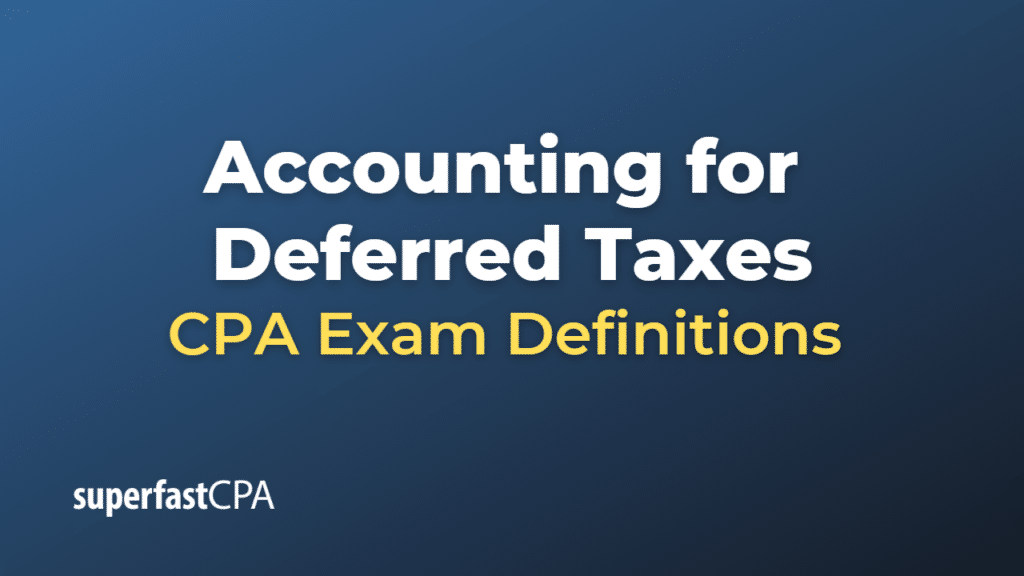Accounting for Deferred Taxes
Accounting for deferred taxes involves the recognition, measurement, and presentation of temporary differences between the tax bases of assets and liabilities and their carrying amounts for financial reporting purposes. Deferred taxes arise due to differences in the timing of income and expense recognition for financial reporting and tax purposes. The main objective of accounting for deferred taxes is to reflect the future tax consequences of these temporary differences.
Under U.S. Generally Accepted Accounting Principles (GAAP) and International Financial Reporting Standards (IFRS), deferred tax accounting is based on the balance sheet liability method, as outlined in the FASB’s ASC Topic 740 and IAS 12, respectively.
There are two types of deferred taxes: deferred tax liabilities and deferred tax assets.
- Deferred Tax Liabilities: These arise when the tax bases of assets are lower than their carrying amounts for financial reporting purposes, leading to higher taxable income in the future. Deferred tax liabilities represent the future tax payments a company will make as these temporary differences reverse.
- Deferred Tax Assets: These arise when the tax bases of liabilities are lower than their carrying amounts for financial reporting purposes or when the tax bases of assets are higher than their carrying amounts, leading to lower taxable income in the future. Deferred tax assets represent the future tax savings a company will realize as these temporary differences reverse.
The process of accounting for deferred taxes involves the following steps:
- Identification: Identify the temporary differences between the tax bases of assets and liabilities and their carrying amounts in the financial statements.
- Measurement: Calculate the deferred tax liabilities or assets by applying the applicable tax rate to the temporary differences.
- Recognition: Record the deferred tax liabilities or assets in the financial statements.
- Reconciliation: Reconcile the beginning and ending balances of deferred tax liabilities or assets, considering changes in tax rates, tax laws, or temporary differences during the reporting period.
- Presentation: Present the deferred tax liabilities or assets on the balance sheet, usually as non-current items.
- Disclosure: Disclose information about the nature and amounts of deferred tax liabilities and assets, the components of the income tax expense, and any unrecognized deferred tax assets due to uncertainty in their realizability, in the notes to the financial statements.
Accounting for deferred taxes ensures that a company’s financial statements reflect the future tax consequences of temporary differences between financial reporting and tax purposes, providing users with a more accurate picture of the company’s financial position and performance.
Example of Accounting for Deferred Taxes
Let’s consider an example of a company that has a temporary difference due to different depreciation methods used for financial reporting and tax purposes.
Example: ABC Corporation purchases a machine for $100,000. The machine has a useful life of 5 years, and the company uses the straight-line depreciation method for financial reporting purposes. However, for tax purposes, the company uses an accelerated depreciation method, such as the double-declining balance method. The applicable tax rate is 25%.
Step 1:
Identification: At the end of the first year, the carrying amount of the machine for financial reporting purposes is $80,000 ($100,000 – ($100,000 ÷ 5)), while its tax base is $60,000 ($100,000 – ($100,000 × 40%)). The temporary difference is $20,000 ($80,000 – $60,000).
Step 2:
Measurement: The deferred tax liability is calculated by applying the tax rate to the temporary difference: $20,000 × 25% = $5,000.
Step 3:
Recognition: ABC Corporation records the deferred tax liability in its financial statements with the following journal entry:
| Debit: Income Tax Expense | $5,000 |
| Credit: Deferred Tax Liability | $5,000 |
Step 4:
Reconciliation: ABC Corporation will continue to analyze and reconcile its deferred tax liability each year until the temporary difference reverses completely.
Step 5:
Presentation: The deferred tax liability is presented as a non-current liability on the balance sheet.
Step 7:
Disclosure: ABC Corporation should disclose information about the deferred tax liability, the nature of the temporary difference (depreciation methods), and the components of the income tax expense in the notes to the financial statements.
By accounting for deferred taxes, ABC Corporation provides users of its financial statements with a more accurate representation of the company’s financial position and performance, considering the future tax consequences of the temporary difference between financial reporting and tax purposes.













